Xiao Xiang Zhu
Technical University of Munich
Learning Generalizable Shape Completion with SIM(3) Equivariance
Sep 30, 2025Abstract:3D shape completion methods typically assume scans are pre-aligned to a canonical frame. This leaks pose and scale cues that networks may exploit to memorize absolute positions rather than inferring intrinsic geometry. When such alignment is absent in real data, performance collapses. We argue that robust generalization demands architectural equivariance to the similarity group, SIM(3), so the model remains agnostic to pose and scale. Following this principle, we introduce the first SIM(3)-equivariant shape completion network, whose modular layers successively canonicalize features, reason over similarity-invariant geometry, and restore the original frame. Under a de-biased evaluation protocol that removes the hidden cues, our model outperforms both equivariant and augmentation baselines on the PCN benchmark. It also sets new cross-domain records on real driving and indoor scans, lowering minimal matching distance on KITTI by 17% and Chamfer distance $\ell1$ on OmniObject3D by 14%. Perhaps surprisingly, ours under the stricter protocol still outperforms competitors under their biased settings. These results establish full SIM(3) equivariance as an effective route to truly generalizable shape completion. Project page: https://sime-completion.github.io.
Multimodal Large Language Models for Medical Report Generation via Customized Prompt Tuning
Jun 18, 2025Abstract:Medical report generation from imaging data remains a challenging task in clinical practice. While large language models (LLMs) show great promise in addressing this challenge, their effective integration with medical imaging data still deserves in-depth exploration. In this paper, we present MRG-LLM, a novel multimodal large language model (MLLM) that combines a frozen LLM with a learnable visual encoder and introduces a dynamic prompt customization mechanism. Our key innovation lies in generating instance-specific prompts tailored to individual medical images through conditional affine transformations derived from visual features. We propose two implementations: prompt-wise and promptbook-wise customization, enabling precise and targeted report generation. Extensive experiments on IU X-ray and MIMIC-CXR datasets demonstrate that MRG-LLM achieves state-of-the-art performance in medical report generation. Our code will be made publicly available.
Taming Stable Diffusion for Computed Tomography Blind Super-Resolution
Jun 13, 2025Abstract:High-resolution computed tomography (CT) imaging is essential for medical diagnosis but requires increased radiation exposure, creating a critical trade-off between image quality and patient safety. While deep learning methods have shown promise in CT super-resolution, they face challenges with complex degradations and limited medical training data. Meanwhile, large-scale pre-trained diffusion models, particularly Stable Diffusion, have demonstrated remarkable capabilities in synthesizing fine details across various vision tasks. Motivated by this, we propose a novel framework that adapts Stable Diffusion for CT blind super-resolution. We employ a practical degradation model to synthesize realistic low-quality images and leverage a pre-trained vision-language model to generate corresponding descriptions. Subsequently, we perform super-resolution using Stable Diffusion with a specialized controlling strategy, conditioned on both low-resolution inputs and the generated text descriptions. Extensive experiments show that our method outperforms existing approaches, demonstrating its potential for achieving high-quality CT imaging at reduced radiation doses. Our code will be made publicly available.
GlobalBuildingAtlas: An Open Global and Complete Dataset of Building Polygons, Heights and LoD1 3D Models
Jun 04, 2025
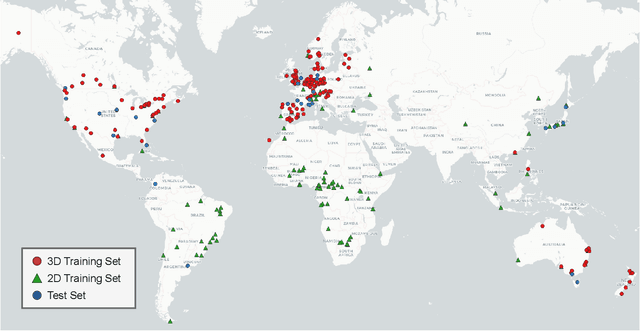

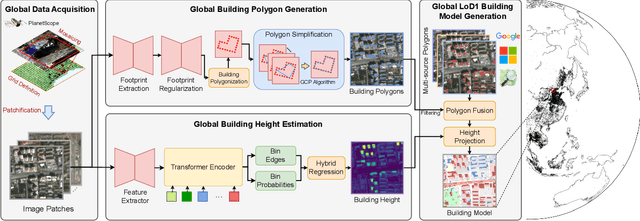
Abstract:We introduce GlobalBuildingAtlas, a publicly available dataset providing global and complete coverage of building polygons, heights and Level of Detail 1 (LoD1) 3D building models. This is the first open dataset to offer high quality, consistent, and complete building data in 2D and 3D form at the individual building level on a global scale. Towards this dataset, we developed machine learning-based pipelines to derive building polygons and heights (called GBA.Height) from global PlanetScope satellite data, respectively. Also a quality-based fusion strategy was employed to generate higher-quality polygons (called GBA.Polygon) based on existing open building polygons, including our own derived one. With more than 2.75 billion buildings worldwide, GBA.Polygon surpasses the most comprehensive database to date by more than 1 billion buildings. GBA.Height offers the most detailed and accurate global 3D building height maps to date, achieving a spatial resolution of 3x3 meters-30 times finer than previous global products (90 m), enabling a high-resolution and reliable analysis of building volumes at both local and global scales. Finally, we generated a global LoD1 building model (called GBA.LoD1) from the resulting GBA.Polygon and GBA.Height. GBA.LoD1 represents the first complete global LoD1 building models, including 2.68 billion building instances with predicted heights, i.e., with a height completeness of more than 97%, achieving RMSEs ranging from 1.5 m to 8.9 m across different continents. With its height accuracy, comprehensive global coverage and rich spatial details, GlobalBuildingAltas offers novel insights on the status quo of global buildings, which unlocks unprecedented geospatial analysis possibilities, as showcased by a better illustration of where people live and a more comprehensive monitoring of the progress on the 11th Sustainable Development Goal of the United Nations.
Building Floor Number Estimation from Crowdsourced Street-Level Images: Munich Dataset and Baseline Method
May 23, 2025Abstract:Accurate information on the number of building floors, or above-ground storeys, is essential for household estimation, utility provision, risk assessment, evacuation planning, and energy modeling. Yet large-scale floor-count data are rarely available in cadastral and 3D city databases. This study proposes an end-to-end deep learning framework that infers floor numbers directly from unrestricted, crowdsourced street-level imagery, avoiding hand-crafted features and generalizing across diverse facade styles. To enable benchmarking, we release the Munich Building Floor Dataset, a public set of over 6800 geo-tagged images collected from Mapillary and targeted field photography, each paired with a verified storey label. On this dataset, the proposed classification-regression network attains 81.2% exact accuracy and predicts 97.9% of buildings within +/-1 floor. The method and dataset together offer a scalable route to enrich 3D city models with vertical information and lay a foundation for future work in urban informatics, remote sensing, and geographic information science. Source code and data will be released under an open license at https://github.com/ya0-sun/Munich-SVI-Floor-Benchmark.
REOBench: Benchmarking Robustness of Earth Observation Foundation Models
May 22, 2025Abstract:Earth observation foundation models have shown strong generalization across multiple Earth observation tasks, but their robustness under real-world perturbations remains underexplored. To bridge this gap, we introduce REOBench, the first comprehensive benchmark for evaluating the robustness of Earth observation foundation models across six tasks and twelve types of image corruptions, including both appearance-based and geometric perturbations. To ensure realistic and fine-grained evaluation, our benchmark focuses on high-resolution optical remote sensing images, which are widely used in critical applications such as urban planning and disaster response. We conduct a systematic evaluation of a broad range of models trained using masked image modeling, contrastive learning, and vision-language pre-training paradigms. Our results reveal that (1) existing Earth observation foundation models experience significant performance degradation when exposed to input corruptions. (2) The severity of degradation varies across tasks, model architectures, backbone sizes, and types of corruption, with performance drop varying from less than 1% to over 20%. (3) Vision-language models show enhanced robustness, particularly in multimodal tasks. REOBench underscores the vulnerability of current Earth observation foundation models to real-world corruptions and provides actionable insights for developing more robust and reliable models.
GlobalGeoTree: A Multi-Granular Vision-Language Dataset for Global Tree Species Classification
May 18, 2025Abstract:Global tree species mapping using remote sensing data is vital for biodiversity monitoring, forest management, and ecological research. However, progress in this field has been constrained by the scarcity of large-scale, labeled datasets. To address this, we introduce GlobalGeoTree, a comprehensive global dataset for tree species classification. GlobalGeoTree comprises 6.3 million geolocated tree occurrences, spanning 275 families, 2,734 genera, and 21,001 species across the hierarchical taxonomic levels. Each sample is paired with Sentinel-2 image time series and 27 auxiliary environmental variables, encompassing bioclimatic, geographic, and soil data. The dataset is partitioned into GlobalGeoTree-6M for model pretraining and curated evaluation subsets, primarily GlobalGeoTree-10kEval for zero-shot and few-shot benchmarking. To demonstrate the utility of the dataset, we introduce a baseline model, GeoTreeCLIP, which leverages paired remote sensing data and taxonomic text labels within a vision-language framework pretrained on GlobalGeoTree-6M. Experimental results show that GeoTreeCLIP achieves substantial improvements in zero- and few-shot classification on GlobalGeoTree-10kEval over existing advanced models. By making the dataset, models, and code publicly available, we aim to establish a benchmark to advance tree species classification and foster innovation in biodiversity research and ecological applications.
ExEBench: Benchmarking Foundation Models on Extreme Earth Events
May 13, 2025Abstract:Our planet is facing increasingly frequent extreme events, which pose major risks to human lives and ecosystems. Recent advances in machine learning (ML), especially with foundation models (FMs) trained on extensive datasets, excel in extracting features and show promise in disaster management. Nevertheless, these models often inherit biases from training data, challenging their performance over extreme values. To explore the reliability of FM in the context of extreme events, we introduce \textbf{ExE}Bench (\textbf{Ex}treme \textbf{E}arth Benchmark), a collection of seven extreme event categories across floods, wildfires, storms, tropical cyclones, extreme precipitation, heatwaves, and cold waves. The dataset features global coverage, varying data volumes, and diverse data sources with different spatial, temporal, and spectral characteristics. To broaden the real-world impact of FMs, we include multiple challenging ML tasks that are closely aligned with operational needs in extreme events detection, monitoring, and forecasting. ExEBench aims to (1) assess FM generalizability across diverse, high-impact tasks and domains, (2) promote the development of novel ML methods that benefit disaster management, and (3) offer a platform for analyzing the interactions and cascading effects of extreme events to advance our understanding of Earth system, especially under the climate change expected in the decades to come. The dataset and code are public https://github.com/zhaoshan2/EarthExtreme-Bench.
TUM2TWIN: Introducing the Large-Scale Multimodal Urban Digital Twin Benchmark Dataset
May 13, 2025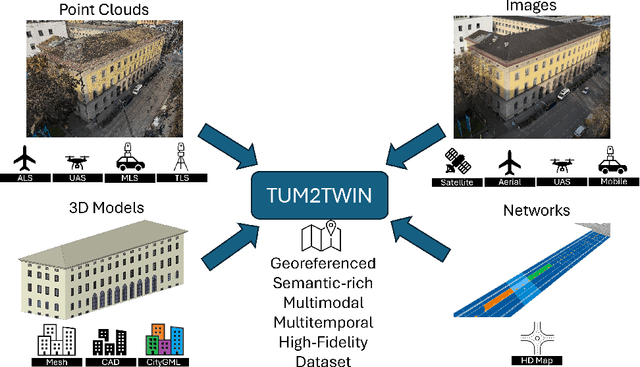

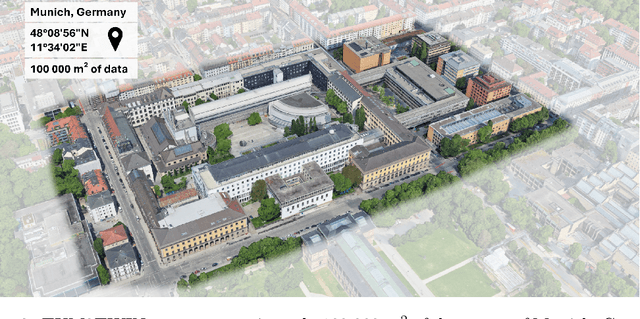
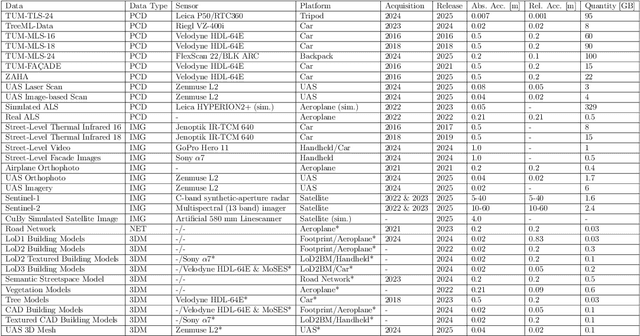
Abstract:Urban Digital Twins (UDTs) have become essential for managing cities and integrating complex, heterogeneous data from diverse sources. Creating UDTs involves challenges at multiple process stages, including acquiring accurate 3D source data, reconstructing high-fidelity 3D models, maintaining models' updates, and ensuring seamless interoperability to downstream tasks. Current datasets are usually limited to one part of the processing chain, hampering comprehensive UDTs validation. To address these challenges, we introduce the first comprehensive multimodal Urban Digital Twin benchmark dataset: TUM2TWIN. This dataset includes georeferenced, semantically aligned 3D models and networks along with various terrestrial, mobile, aerial, and satellite observations boasting 32 data subsets over roughly 100,000 $m^2$ and currently 767 GB of data. By ensuring georeferenced indoor-outdoor acquisition, high accuracy, and multimodal data integration, the benchmark supports robust analysis of sensors and the development of advanced reconstruction methods. Additionally, we explore downstream tasks demonstrating the potential of TUM2TWIN, including novel view synthesis of NeRF and Gaussian Splatting, solar potential analysis, point cloud semantic segmentation, and LoD3 building reconstruction. We are convinced this contribution lays a foundation for overcoming current limitations in UDT creation, fostering new research directions and practical solutions for smarter, data-driven urban environments. The project is available under: https://tum2t.win
Global Collinearity-aware Polygonizer for Polygonal Building Mapping in Remote Sensing
May 02, 2025Abstract:This paper addresses the challenge of mapping polygonal buildings from remote sensing images and introduces a novel algorithm, the Global Collinearity-aware Polygonizer (GCP). GCP, built upon an instance segmentation framework, processes binary masks produced by any instance segmentation model. The algorithm begins by collecting polylines sampled along the contours of the binary masks. These polylines undergo a refinement process using a transformer-based regression module to ensure they accurately fit the contours of the targeted building instances. Subsequently, a collinearity-aware polygon simplification module simplifies these refined polylines and generate the final polygon representation. This module employs dynamic programming technique to optimize an objective function that balances the simplicity and fidelity of the polygons, achieving globally optimal solutions. Furthermore, the optimized collinearity-aware objective is seamlessly integrated into network training, enhancing the cohesiveness of the entire pipeline. The effectiveness of GCP has been validated on two public benchmarks for polygonal building mapping. Further experiments reveal that applying the collinearity-aware polygon simplification module to arbitrary polylines, without prior knowledge, enhances accuracy over traditional methods such as the Douglas-Peucker algorithm. This finding underscores the broad applicability of GCP. The code for the proposed method will be made available at https://github.com/zhu-xlab.
 Add to Chrome
Add to Chrome Add to Firefox
Add to Firefox Add to Edge
Add to Edge